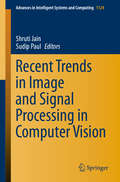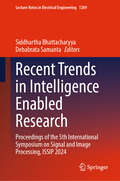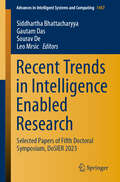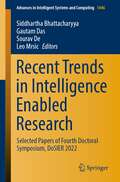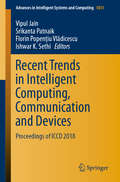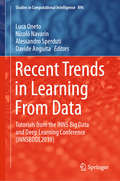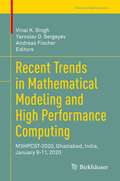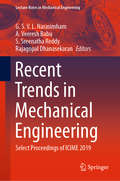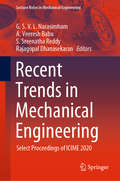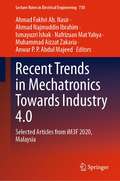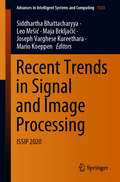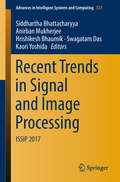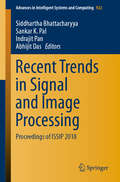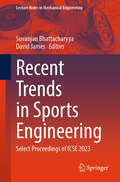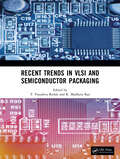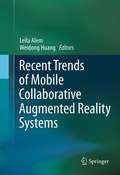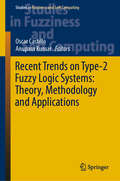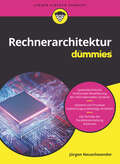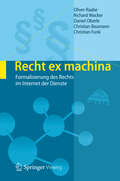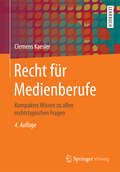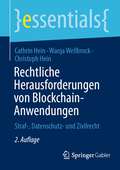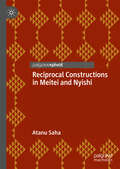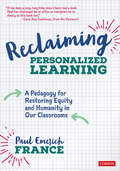- Table View
- List View
Recent Trends in Image and Signal Processing in Computer Vision (Advances in Intelligent Systems and Computing #1124)
by Sudip Paul Shruti JainThis book highlights recent advances and emerging technologies that utilize computational intelligence in signal processing, computing, imaging science, artificial intelligence, and their applications. It covers all branches of artificial intelligence and machine learning that are based on computation at some level, e.g. artificial neural networks, evolutionary algorithms, fuzzy systems, and automatic medical identification systems. Exploring recent trends in research and applications, the book offers a valuable resource for professors, researchers, and engineers alike.
Recent Trends in Intelligence Enabled Research: Proceedings of the 5th International Symposium on Signal and Image Processing, ISSIP 2024 (Lecture Notes in Electrical Engineering #1269)
by Siddhartha Bhattacharyya Debabrata SamantaThis book gathers selected papers presented at the Fifth International Symposium on Signal and Image Processing (ISSIP 2024). It presents fascinating state-of-the-art research findings in signal and image processing. It includes conference papers covering many signal-processing applications involving filtering, encoding, classification, segmentation, clustering, feature extraction, denoising, watermarking, object recognition, reconstruction, and fractal analysis. It addresses various types of signals, such as image, video, speech, non-speech audio, handwritten text, geometric diagram, and ECG and EMG signals; MRI, PET, and CT scan images; THz signals; solar wind speed (SWS) signals; and photoplethysmography (PPG) signals, and demonstrates how new paradigms of intelligent computing, like quantum computing, can be applied to process and analyze signals precisely and effectively.
Recent Trends in Intelligence Enabled Research: Selected Papers of Fifth Doctoral Symposium, DoSIER 2023 (Advances in Intelligent Systems and Computing #1457)
by Siddhartha Bhattacharyya Sourav De Gautam Das Leo MrsicThis book gathers extended versions of papers presented at DoSIER 2023 (Fifth Doctoral Symposium on Intelligence Enabled Research, held at Cooch Behar Government Engineering College, West Bengal, India, during December 20–21, 2023). The papers address the rapidly expanding research area of computational intelligence, which, no longer limited to specific computational fields, has since made inroads in signal processing, smart manufacturing, predictive control, robot navigation, smart cities, and sensor design, to name but a few. Presenting chapters written by experts active in these areas, the book offers a valuable reference guide for researchers and industrial practitioners alike and inspires future studies.
Recent Trends in Intelligence Enabled Research: Selected Papers of Fourth Doctoral Symposium, DoSIER 2022 (Advances in Intelligent Systems and Computing #1446)
by Siddhartha Bhattacharyya Sourav De Gautam Das Leo MrsicThis book gathers extended versions of papers presented at DoSIER 2022 (Fourth Doctoral Symposium on Intelligence Enabled Research, held at Cooch Behar Government Engineering College, West Bengal, India, during 22–23 December 2022). The papers address the rapidly expanding research area of computational intelligence, which, no longer limited to specific computational fields, has since made inroads in signal processing, smart manufacturing, predictive control, robot navigation, smart cities, and sensor design, to name but a few. Presenting chapters written by experts active in these areas, the book offers a valuable reference guide for researchers and industrial practitioners alike and inspires future studies.
Recent Trends in Intelligent Computing, Communication and Devices: Proceedings of ICCD 2018 (Advances in Intelligent Systems and Computing #1006)
by Vipul Jain Ishwar K. Sethi Srikanta Patnaik Florin Popențiu VlădicescuThis book gathers a collection of high-quality, peer-reviewed research papers presented at the International Conference on Intelligent Computing, Communication and Devices (ICCD 2018), which address three core dimensions of the intelligent sciences—intelligent computing, intelligent communication, and intelligent devices. Intelligent computing includes areas such as intelligent and distributed computing, intelligent grid and cloud computing, Internet of Things, soft computing and engineering applications, data mining and knowledge discovery, semantic and web technology, hybrid systems, agent computing, bioinformatics, and recommendation systems. In turn, intelligent communication is concerned with communication and network technologies, such as mobile broadband and all-optical networks, which are the key to groundbreaking advances in intelligent communication technologies. It includes communication hardware, software and networked intelligence, mobile technologies, machine-to-machine communication networks, speech and natural language processing, routing techniques and network analytics, wireless ad hoc and sensor networks, communications and information security, signal, image and video processing, network management, and traffic engineering. Lastly, intelligent devices refer to any equipment, instruments, or machines that have their own computing capability, and covers areas such as embedded systems, radiofrequency identification (RFID), radiofrequency microelectromechanical systems (RF MEMS), very large-scale integration (VLSI) design and electronic devices, analog and mixed-signal integrated circuit (IC) design and testing, microelectromechanical systems (MEMS) and microsystems, solar cells and photonics, nanodevices, single electron and spintronic devices, space electronics, and intelligent robotics.
Recent Trends in Learning From Data: Tutorials from the INNS Big Data and Deep Learning Conference (INNSBDDL2019) (Studies in Computational Intelligence #896)
by Luca Oneto Davide Anguita Nicolò Navarin Alessandro SperdutiThis book offers a timely snapshot and extensive practical and theoretical insights into the topic of learning from data. Based on the tutorials presented at the INNS Big Data and Deep Learning Conference, INNSBDDL2019, held on April 16-18, 2019, in Sestri Levante, Italy, the respective chapters cover advanced neural networks, deep architectures, and supervised and reinforcement machine learning models. They describe important theoretical concepts, presenting in detail all the necessary mathematical formalizations, and offer essential guidance on their use in current big data research.
Recent Trends in Manufacturing and Materials Towards Industry 4.0: Selected Articles from iM3F 2020, Malaysia (Lecture Notes in Mechanical Engineering)
by Muhammed Nafis Osman Zahid Amiril Sahab Abdul Sani Mohamad Rusydi Mohamad Yasin Zulhelmi Ismail Nurul Akmal Che Lah Faiz Mohd TuranThis book presents part of the proceedings of the Manufacturing and Materials track of the iM3F 2020 conference held in Malaysia. This collection of articles deliberates on the key challenges and trends related to manufacturing as well as materials engineering and technology in setting the stage for the world in embracing the fourth industrial revolution. It presents recent findings with regards to manufacturing and materials that are pertinent towards the realizations and ultimately the embodiment of Industry 4.0, with contributions from both industry and academia.
Recent Trends in Mathematical Modeling and High Performance Computing: M3HPCST-2020, Ghaziabad, India, January 9-11, 2020 (Trends in Mathematics)
by Yaroslav D. Sergeyev Vinai K. Singh Andreas FischerThis volume explores the connections between mathematical modeling, computational methods, and high performance computing, and how recent developments in these areas can help to solve complex problems in the natural sciences and engineering. The content of the book is based on talks and papers presented at the conference Modern Mathematical Methods and High Performance Computing in Science & Technology (M3HPCST), held at Inderprastha Engineering College in Ghaziabad, India in January 2020. A wide range of both theoretical and applied topics are covered in detail, including the conceptualization of infinity, efficient domain decomposition, high capacity wireless communication, infectious disease modeling, and more. These chapters are organized around the following areas:Partial and ordinary differential equationsOptimization and optimal controlHigh performance and scientific computingStochastic models and statistics Recent Trends in Mathematical Modeling and High Performance Computing will be of interest to researchers in both mathematics and engineering, as well as to practitioners who face complex models and extensive computations.
Recent Trends in Mechanical Engineering: Select Proceedings of ICIME 2019 (Lecture Notes in Mechanical Engineering)
by G. S. V. L. Narasimham A. Veeresh Babu S. Sreenatha Reddy Rajagopal DhanasekaranThis book comprises select peer-reviewed proceedings from the International Conference on Innovations in Mechanical Engineering (ICIME 2019). The volume covers current research in almost all major areas of mechanical engineering, and is divided into six parts: (i) automobile and thermal engineering, (ii) design and optimization, (iii) production and industrial engineering, (iv) material science and metallurgy, (v) nanoscience and nanotechnology, and (vi) renewable energy sources and CAD/CAM/CFD. The topics provide insights into different aspects of designing, modeling, manufacturing, optimizing, and processing with wide ranging applications. The contents of this book can be of interest to researchers and professionals alike.
Recent Trends in Mechanical Engineering: Select Proceedings of ICIME 2020 (Lecture Notes in Mechanical Engineering)
by G. S. V. L. Narasimham A. Veeresh Babu S. Sreenatha Reddy Rajagopal DhanasekaranThis book consists of peer-reviewed proceedings from the International Conference on Innovations in Mechanical Engineering (ICIME 2020). The contents cover latest research in all major areas of mechanical engineering, and are broadly divided into five parts: (i) thermal engineering, (ii) design and optimization, (iii) production and industrial engineering, (iv) materials science and metallurgy, and (v) multidisciplinary topics. Different aspects of designing, modeling, manufacturing, optimizing, and processing are discussed in the context of emerging applications. Given the range of topics covered, this book can be useful for students, researchers as well as professionals.
Recent Trends in Mechatronics Towards Industry 4.0: Selected Articles from iM3F 2020, Malaysia (Lecture Notes in Electrical Engineering #730)
by Anwar P. P. Abdul Majeed Nafrizuan Mat Yahya Muhammad Aizzat Zakaria Ahmad Fakhri Ab. Nasir Ahmad Najmuddin Ibrahim Ismayuzri IshakThis book presents part of the iM3F 2020 proceedings from the Mechatronics track. It highlights key challenges and recent trends in mechatronics engineering and technology that are non-trivial in the age of Industry 4.0. It discusses traditional as well as modern solutions that are employed in the multitude spectra of mechatronics-based applications. The readers are expected to gain an insightful view on the current trends, issues, mitigating factors as well as solutions from this book.
Recent Trends in Signal and Image Processing: ISSIP 2020 (Advances in Intelligent Systems and Computing #1333)
by Siddhartha Bhattacharyya Mario Koeppen Leo Mršić Maja Brkljačić Joseph Varghese KureetharaThis book gathers selected papers presented at the Third International Symposium on Signal and Image Processing (ISSIP 2020), organized by the Department of Information Technology, RCC Institute of Information Technology, Kolkata, during March 18–19, 2020. It presents fascinating, state-of-the-art research findings in the field of signal and image processing. It includes conference papers covering a wide range of signal processing applications involving filtering, encoding, classification, segmentation, clustering, feature extraction, denoising, watermarking, object recognition, reconstruction and fractal analysis. It addresses various types of signals, such as image, video, speech, non-speech audio, handwritten text, geometric diagram, ECG and EMG signals; MRI, PET and CT scan images; THz signals; solar wind speed signals (SWS); and photoplethysmogram (PPG) signals, and demonstrates how new paradigms of intelligent computing, like quantum computing, can be applied to process and analyze signals precisely and effectively.
Recent Trends in Signal and Image Processing: Issip 2017 (Advances In Intelligent Systems And Computing #727)
by Swagatam Das Siddhartha Bhattacharyya Anirban Mukherjee Hrishikesh Bhaumik Kaori YoshidaThis book contains interesting findings of some state-of-the-art research in the field of signal and image processing. It contains twenty one chapters covering a wide range of signal processing applications involving filtering, encoding, classification, segmentation, clustering, feature extraction, denoising, watermarking, object recognition, reconstruction and fractal analysis. Various types of signals including image, video, speech, non-speech audio, handwritten text, geometric diagram, ECG and EMG signals, MRI, PET and CT scan images, THz signals, solar wind speed signals (SWS) and photoplethysmogram (PPG) signals have been dealt with. It demonstrates how new paradigms of intelligent computing like quantum computing can be applied to process and analyze signals in a most precise and effective manner. Processing of high precision signals for real time target recognition by radar and processing of brain images, ECG and EMG signals that feature in this book have significant implications in defense mechanism and medical diagnosis. There are also applications of hybrid methods, algorithms and image filters which are proving to be better than the individual techniques or algorithms. Thus the present volume, enriched in depth and variety of techniques and algorithms concerning processing of various types of signals, is likely to be used as a compact yet handy reference for the young researchers, academicians and scientists working in the domain of signal and image processing and also to the post graduate students of computer science and information technology.
Recent Trends in Signal and Image Processing: Issip 2017 (Advances in Intelligent Systems and Computing #727)
by Sankar K. Pal Abhijit Das Siddhartha Bhattacharyya Indrajit PanThis book presents fascinating, state-of-the-art research findings in the field of signal and image processing. It includes conference papers covering a wide range of signal processing applications involving filtering, encoding, classification, segmentation, clustering, feature extraction, denoising, watermarking, object recognition, reconstruction and fractal analysis. It addresses various types of signals, such as image, video, speech, non-speech audio, handwritten text, geometric diagram, ECG and EMG signals; MRI, PET and CT scan images; THz signals; solar wind speed signals (SWS); and photoplethysmogram (PPG) signals, and demonstrates how new paradigms of intelligent computing, like quantum computing, can be applied to process and analyze signals precisely and effectively. The book also discusses applications of hybrid methods, algorithms and image filters, which are proving to be better than the individual techniques or algorithms.
Recent Trends in Sports Engineering: Select Proceedings of ICSE 2023 (Lecture Notes in Mechanical Engineering)
by David James Suvanjan BhattacharyyaThis book presents the select proceedings of 3rd International Conference on Sports Engineering (ICSE 2023). It bridges the gap between sports industry and academia for improving sports infrastructure and facilities. Various topics covered in this book are design, manufacturing and testing of synthetic sports surfaces, design of training aids in sports, fitness and recreation activities, simulation and mathematical modelling of sports performance, designing sports facilities including indoor and outdoor Stadium, wearable exoskeletons and prosthesis in para sports, Olympic and Paralympic Sports equipment, artificial intelligence in sports training & performance, machine learning and computer vision, computer-aided design and application in sports, computer supported sports training and performance prediction, video analysis and image processing, sports analytics and data science. The book is useful for researchers and professionals working in the area of sports engineering.
Recent Trends in VLSI and Semiconductor Packaging
by T. Vasudeva Reddy K. Madhava RaoThe International conference on Semiconductor Materials packaging, AI&ML, Reconfigurable VLSI architectures for IoT, future Communication Technologies (“SMART-2024”) aimed to provide a platform for researchers, academicians, industry experts, and practitioners to exchange ideas, present research findings, and discuss emerging trends and challenges in the specified fields. “SMART-2024” seeked to foster collaboration, innovation, and knowledge dissemination by bringing together experts and stakeholders from diverse backgrounds to address key issues and explore new research directions. The conference targeted a diverse audience including researchers, academicians, scientists, engineers, technologists, industry professionals, students, policymakers, and other stakeholders interested in VLSI, IoT, AI-ML, communication systems, semiconductor packaging, hetero architecture devices, and Nano materials.
Recent Trends of Mobile Collaborative Augmented Reality Systems
by Weidong Huang Leila AlemThe use of mobile collaborative AR has expended rapidly in recent years, due to the major advances in hardware and networking. The application areas are diverse and multidisciplinary. Recent Trends of Mobile Collaborative Augmented Reality Systems provides a historical overview of previous mobile collaborative AR systems, presents case studies of latest developments in current mobile collaborative AR systems, and latest technologies and system architectures used in this field. Recent Trends of Mobile Collaborative Augmented Reality Systems is designed for a professional audience composed of practitioners and researchers working in the field of augmented reality and human-computer interaction. Advanced-level students in computer science and electrical engineering focused on this topic will also find this book useful as a secondary text or reference.
Recent Trends on Type-2 Fuzzy Logic Systems: Theory, Methodology and Applications (Studies in Fuzziness and Soft Computing #425)
by Oscar Castillo Anupam KumarThis book covers the introduction, theory, development and applications of type-2 fuzzy logic systems, which represent the current state-of-the-art in various domains such as control applications, power plants, health care, image processing, mathematical applications etc. The book is also rich in discussing different applications in order to give the researchers a flavor of how type-2 fuzzy logic is designed for different types of problems. Type-2 fuzzy logic systems are now used extensively in engineering applications for many purposes. In simple language, this book covers the practical use of type-2 fuzzy logic and its optimization through different training methods. Furthermore, this book maintains the relationship between mathematics and practical implementations in the real world. This book chapter also contains the proper comparisons with available literature work. It shows that the presented enhanced techniques have better results. This book would serve as a handy reference guide for a variety of readers, primarily targeting research scholars, undergraduate and postgraduate researchers and practicing engineers working in Type-2 fuzzy logic systems and their applications.
Rechnerarchitektur für Dummies (Für Dummies)
by Jürgen NeuschwanderDieses Buch bietet eine kompakte, verständliche Einführung in das Thema "Rechnerarchitektur". Alle heute essenziellen Themengebiete werden behandelt. Der Schwerpunkt des Buches liegt auf der systemtechnischen funktionalen Beschreibung von Rechnern, ihren Komponenten und Prozessen, ohne auf die unzähligen Details dedizierter Systeme einzugehen. Die funktionale Darstellung mittels geeigneter Modellierungstechniken erlaubt das grundsätzliche Verständnis dieser Systeme, unabhängig von der jeweiligen Art der Realisierung und dem aktuellen Stand der Technologie. So müssen Sie keine Sorge haben, dass Sie sich bei der Prüfungsvorbereitung in den Details verlieren.
Recht ex machina
by Christian Baumann Daniel Oberle Richard Wacker Christian Funk Oliver RaabeIm Internet werden Informationen immer häufiger so ausgezeichnet, dass sie für Computer interpretierbar sind (Semantic Web). Solche maschinenlesbaren Informationen sorgen dafür, dass Dienste im Internet verfügbar gemacht und gefunden werden können. Diese Automatisierung schafft eine neue Rechtslage und stellt sowohl für die Rechtspflege als auch für Geschäftspartner eine Herausforderung dar. In dem Band präsentieren die Autoren eine automatisierte Rechtsfolgenermittlung als praxisrelevanten Ansatz zur Herstellung von Rechtssicherheit.
Recht für Medienberufe
by Clemens KaeslerMit diesem Buch finden Sie sich schnell im Dschungel der medienspezifischen Rechtsfragen zurecht. Es orientiert sich am Lehrplan und hilft Ihnen, die für Ihren Beruf relevanten Themen schnell zu begreifen und mit ihnen umgehen zu können. Insbesondere liegt der Schwerpunkt auf dem Urheberrecht, dem Kennzeichen- und Markenrecht, dem Internetrecht, dem Wettbewerbsrecht sowie dem Datenschutz und Presserecht.
Rechtliche Herausforderungen von Blockchain-Anwendungen: Straf-, Datenschutz- und Zivilrecht (essentials)
by Cathrin Hein Wanja Wellbrock Christoph HeinDas essential fasst den aktuellen Stand der rechtlichen Herausforderungen der Blockchain-Technologie anhand von Beispielen kurz und prägnant zusammen. Als branchen-revolutionierende Technologie stellt die Blockchain das Recht vor besondere Herausforderungen. Die Pseudonymität der Blockchain-Teilnehmer und die Unveränderbarkeit von in der Blockchain gespeicherten Daten scheinen im Konflikt mit wesentlichen Grundgedanken des Datenschutzrechts zu stehen. Auch die Frage nach der national anzuwendenden Rechtsordnung, der gerichtlichen Zuständigkeit und der Beweiskraft von Blockchain-Transaktionen werfen spannende Fragen auf. Die Autoren erörtern Aspekte des Straf- und Zivilrechts und zeigen Lösungsansätze. Die 2. Auflage des Essentials spiegelt alle rechtlichen Entwicklungen der letzten Jahre wider, sodass die Leser stets auf dem aktuellsten Stand sind.
Reciprocal Constructions in Meitei and Nyishi
by Atanu SahaThis book investigates three interesting questions arising from the intriguing cross-linguistic perspective of Meiteilon and Nyishi, two Tibeto-Burman languages respectively spoken in the states of Manipur and Arunachal Pradesh in India. The first question relates to developing a model for the syntax and semantics of these verbal reciprocal languages. Secondly, the book attempts to provide an account of the surface variations between the languages using this model. The book also tries to build an account for the co-occurrences of the nominal and verbal reciprocals in languages like Meiteilon and Nyishi. Both languages use a verbal strategy for default reciprocalization and both the languages show discontinuous reciprocity. The author argues that if the reciprocal marker consists of one suffix (as in the case of Meiteilon), it may express several other functions, but if the reciprocal marker composes of more than one suffix (as in Nyishi), it does not show polysemy. Both languages can reciprocalize unaccusative and unergative verbs, and in both the languages, overt distributive nominal reciprocal markers show strong reciprocity. This book will be of interest to syntacticians and typologists working in the domain of universal grammar, as well as computational linguists seeking empirical data on endangered and underrepresented languages.
Reciprocity, Evolution, and Decision Games in Network and Data Science
by Yan Chen Chunxiao Jiang Chih-Yu Wang K.J. Ray LiuLearn how to analyse and manage evolutionary and sequential user behaviours in modern networks, and how to optimize network performance by using indirect reciprocity, evolutionary games, and sequential decision making. Understand the latest theory without the need to go through the details of traditional game theory. With practical management tools to regulate user behaviour, and simulations and experiments with real data sets, this is an ideal tool for graduate students and researchers working in networking, communications, and signal processing.
Reclaiming Personalized Learning: A Pedagogy for Restoring Equity and Humanity in Our Classrooms
by Paul Emerich FranceWhere exactly did personalized learning go so wrong? For teacher and consultant Paul France, at first technology-powered personalized learning seemed like a panacea. But after three years spent at a personalized learning start-up and network of microschools, he soon realized that such corporate-driven individualized learning initiatives do more harm than good, especially among our most vulnerable students. The far-superior alternative? A human-centered pedagogy that prioritizes children over technology. First, let’s be clear: Reclaiming Personalized Learning is not yet-another ed tech book. Instead it’s a user’s guide to restoring equity and humanity to our classrooms and schools through personalization. One part polemical, eleven parts practical, the book describes how to: Shape whole-class instruction, leverage small-group interactions, and nurture a student’s inner-dialogue Cultivate awareness within and among students, and build autonomy and authority Design curriculum with a flexible frame and where exactly the standards fit Humanize assessment and instruction, including the place of responsive teaching Create a sense of belonging, humanize technology integration, and effect socially just teaching and learning—all central issues in equity The truth is this: there’s no one framework, there’s no one tool that makes learning personalized–what personalized learning companies with a vested interest in profits might tempt you to believe. It’s people who personalize learning, and people not technology must be at the center of education. The time is now for all of us teachers to reclaim personalized learning, and this all-important book is our very best resource for getting started. “This is a compelling and critically important book for our time. With rich stories of teaching and learning Paul France considers ways to create the most positive learning experiences possible.” - JO BOALER, Nomellini & Olivier Professor of Education, Stanford Graduate School of Education “This brilliant book is a major contribution to the re-imagination of learning and teaching for the twenty-first century and should be essential reading for new and experienced teachers alike." - TONY WAGNER, Senior Research Fellow, Learning Policy Institute “In these troubled times, this book is more than a breath of fresh air, it is a call to action. Paul gives us an accessible and sophisticated book that explains how and why we should celebrate the humanity of every single student.” - JIM KNIGHT, Senior Partner of the Instructional Coaching Group (ICG) and Author of The Impact Cycle
